COIT12208 Project Management: Bike Share Australia Project Plan
VerifiedAdded on 2023/06/12
|9
|1343
|203
Case Study
AI Summary
This case study provides a detailed analysis of the Bike Share Australia project, addressing key aspects of project management. It begins by resolving resource allocation issues through resource leveling, extending the project duration from 161 to 205 days while maintaining the same total cost. A memo outlines the successful project planning stage, highlighting the project's objectives and schedule, which includes activities such as software database development, accounting management system implementation, GPS tracking, and mobile interface app creation. The study also evaluates the impact of business analyst involvement on minimizing project duration. Furthermore, it identifies potential project risks, such as system incompatibility and data loss during development, and incorporates activities into the Work Breakdown Structure (WBS). The analysis concludes with revisions to the project plan, assessing the impact of changes on project duration and cost across different sprints, with detailed explanations for each adjustment. This document is available on Desklib, a platform offering a variety of study tools and solved assignments for students.
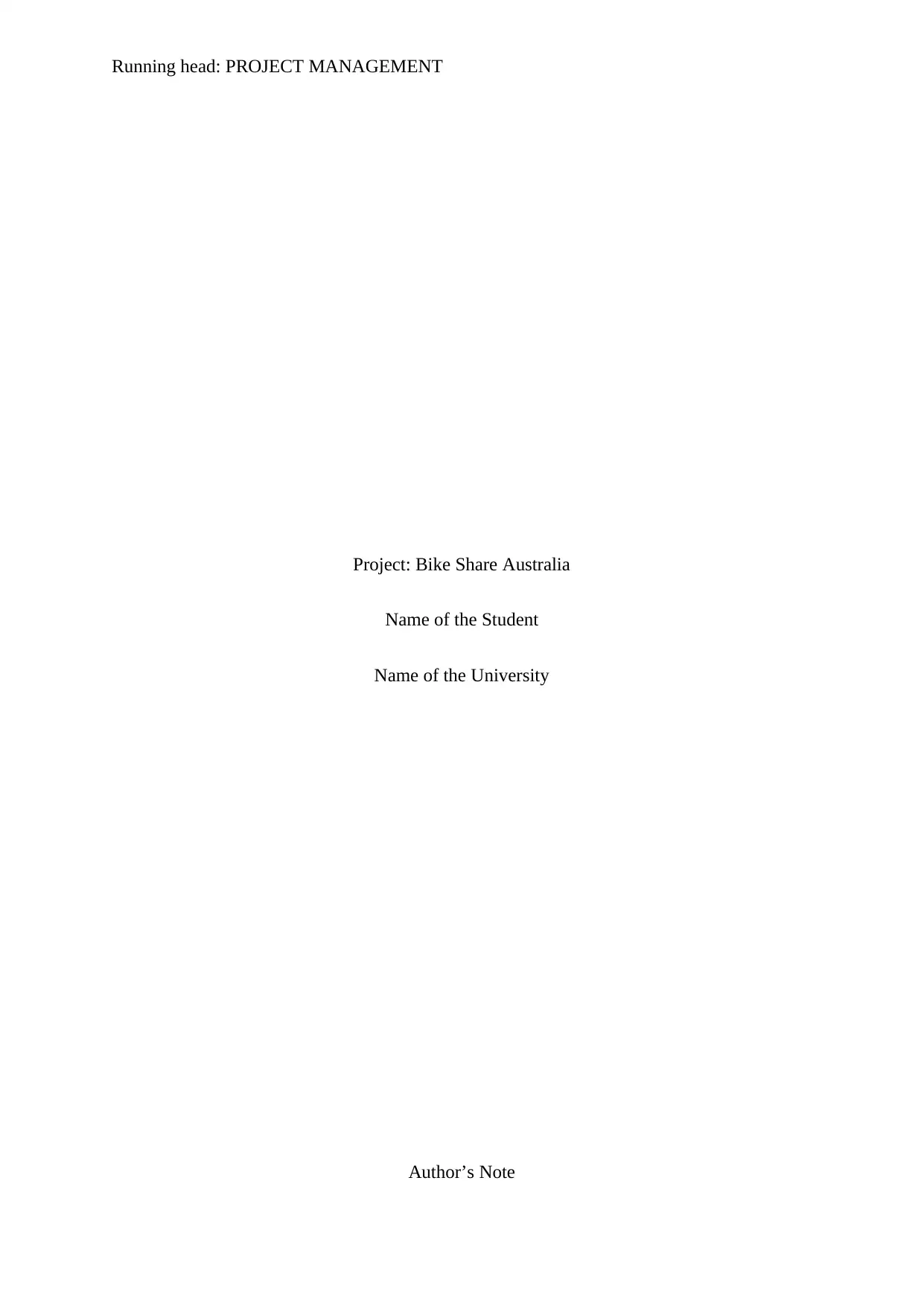
Running head: PROJECT MANAGEMENT
Project: Bike Share Australia
Name of the Student
Name of the University
Author’s Note
Project: Bike Share Australia
Name of the Student
Name of the University
Author’s Note
Paraphrase This Document
Need a fresh take? Get an instant paraphrase of this document with our AI Paraphraser
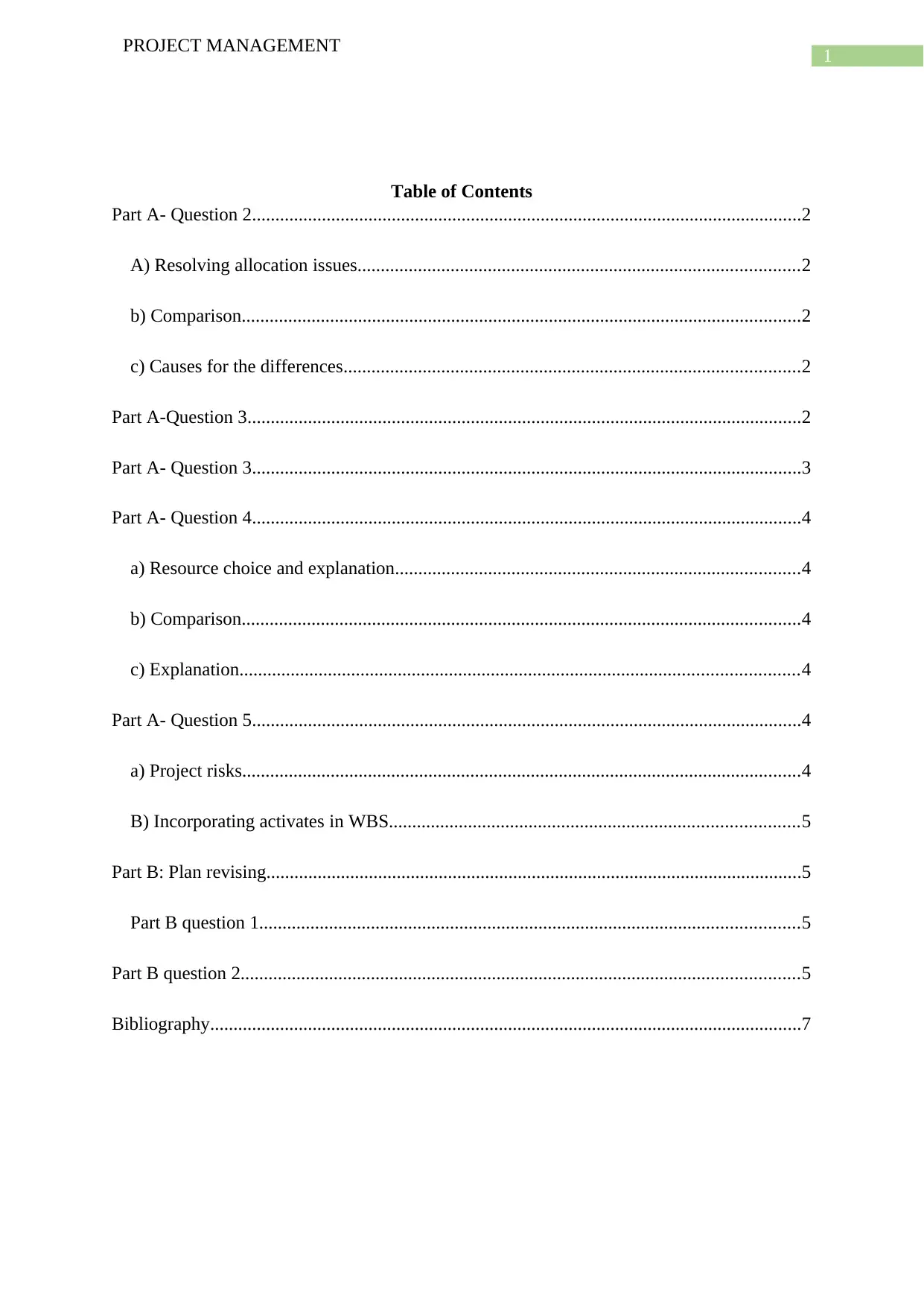
1
PROJECT MANAGEMENT
Table of Contents
Part A- Question 2......................................................................................................................2
A) Resolving allocation issues...............................................................................................2
b) Comparison........................................................................................................................2
c) Causes for the differences..................................................................................................2
Part A-Question 3.......................................................................................................................2
Part A- Question 3......................................................................................................................3
Part A- Question 4......................................................................................................................4
a) Resource choice and explanation.......................................................................................4
b) Comparison........................................................................................................................4
c) Explanation........................................................................................................................4
Part A- Question 5......................................................................................................................4
a) Project risks........................................................................................................................4
B) Incorporating activates in WBS........................................................................................5
Part B: Plan revising...................................................................................................................5
Part B question 1....................................................................................................................5
Part B question 2........................................................................................................................5
Bibliography...............................................................................................................................7
PROJECT MANAGEMENT
Table of Contents
Part A- Question 2......................................................................................................................2
A) Resolving allocation issues...............................................................................................2
b) Comparison........................................................................................................................2
c) Causes for the differences..................................................................................................2
Part A-Question 3.......................................................................................................................2
Part A- Question 3......................................................................................................................3
Part A- Question 4......................................................................................................................4
a) Resource choice and explanation.......................................................................................4
b) Comparison........................................................................................................................4
c) Explanation........................................................................................................................4
Part A- Question 5......................................................................................................................4
a) Project risks........................................................................................................................4
B) Incorporating activates in WBS........................................................................................5
Part B: Plan revising...................................................................................................................5
Part B question 1....................................................................................................................5
Part B question 2........................................................................................................................5
Bibliography...............................................................................................................................7
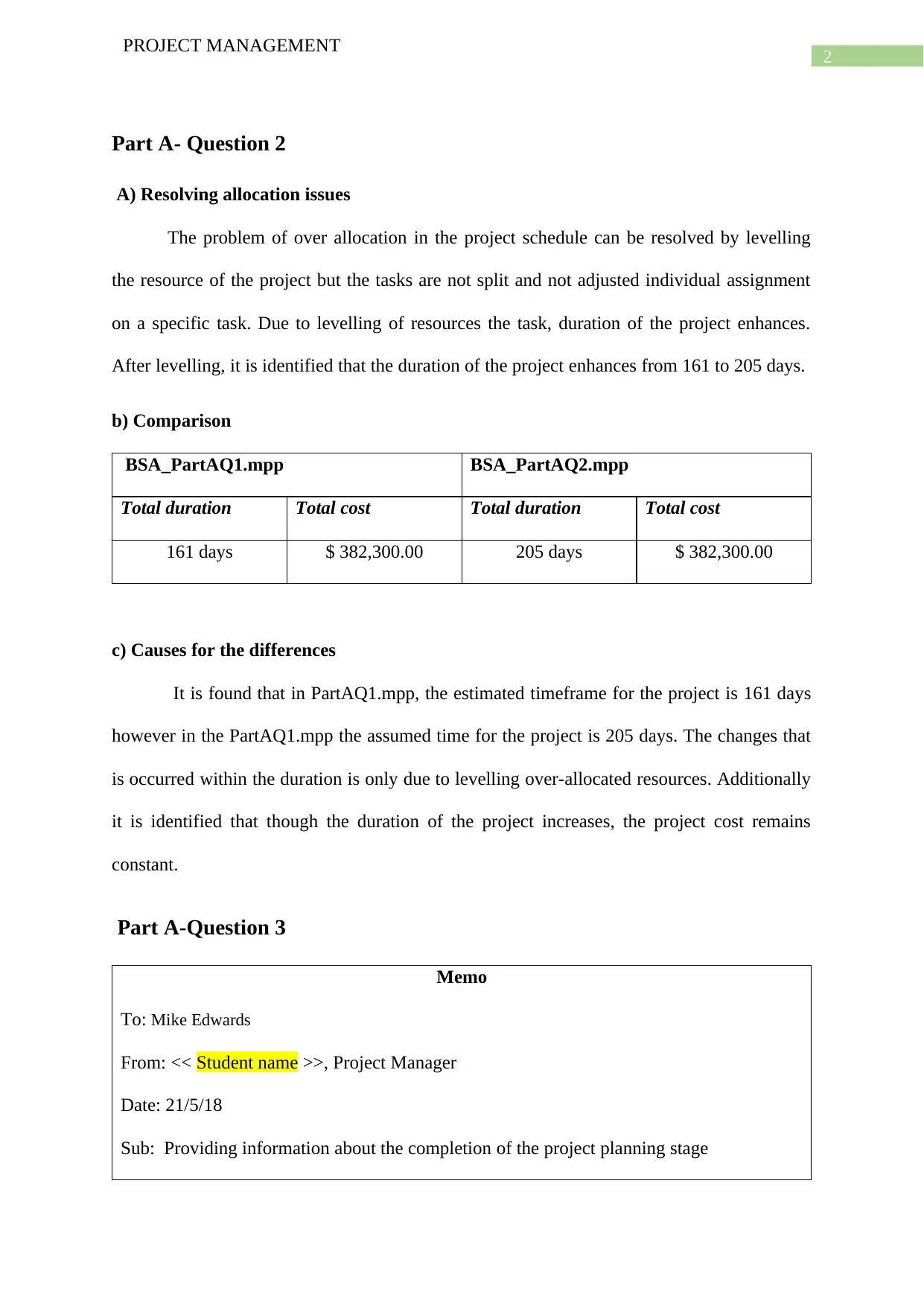
2
PROJECT MANAGEMENT
Part A- Question 2
A) Resolving allocation issues
The problem of over allocation in the project schedule can be resolved by levelling
the resource of the project but the tasks are not split and not adjusted individual assignment
on a specific task. Due to levelling of resources the task, duration of the project enhances.
After levelling, it is identified that the duration of the project enhances from 161 to 205 days.
b) Comparison
BSA_PartAQ1.mpp BSA_PartAQ2.mpp
Total duration Total cost Total duration Total cost
161 days $ 382,300.00 205 days $ 382,300.00
c) Causes for the differences
It is found that in PartAQ1.mpp, the estimated timeframe for the project is 161 days
however in the PartAQ1.mpp the assumed time for the project is 205 days. The changes that
is occurred within the duration is only due to levelling over-allocated resources. Additionally
it is identified that though the duration of the project increases, the project cost remains
constant.
Part A-Question 3
Memo
To: Mike Edwards
From: << Student name >>, Project Manager
Date: 21/5/18
Sub: Providing information about the completion of the project planning stage
PROJECT MANAGEMENT
Part A- Question 2
A) Resolving allocation issues
The problem of over allocation in the project schedule can be resolved by levelling
the resource of the project but the tasks are not split and not adjusted individual assignment
on a specific task. Due to levelling of resources the task, duration of the project enhances.
After levelling, it is identified that the duration of the project enhances from 161 to 205 days.
b) Comparison
BSA_PartAQ1.mpp BSA_PartAQ2.mpp
Total duration Total cost Total duration Total cost
161 days $ 382,300.00 205 days $ 382,300.00
c) Causes for the differences
It is found that in PartAQ1.mpp, the estimated timeframe for the project is 161 days
however in the PartAQ1.mpp the assumed time for the project is 205 days. The changes that
is occurred within the duration is only due to levelling over-allocated resources. Additionally
it is identified that though the duration of the project increases, the project cost remains
constant.
Part A-Question 3
Memo
To: Mike Edwards
From: << Student name >>, Project Manager
Date: 21/5/18
Sub: Providing information about the completion of the project planning stage
⊘ This is a preview!⊘
Do you want full access?
Subscribe today to unlock all pages.

Trusted by 1+ million students worldwide
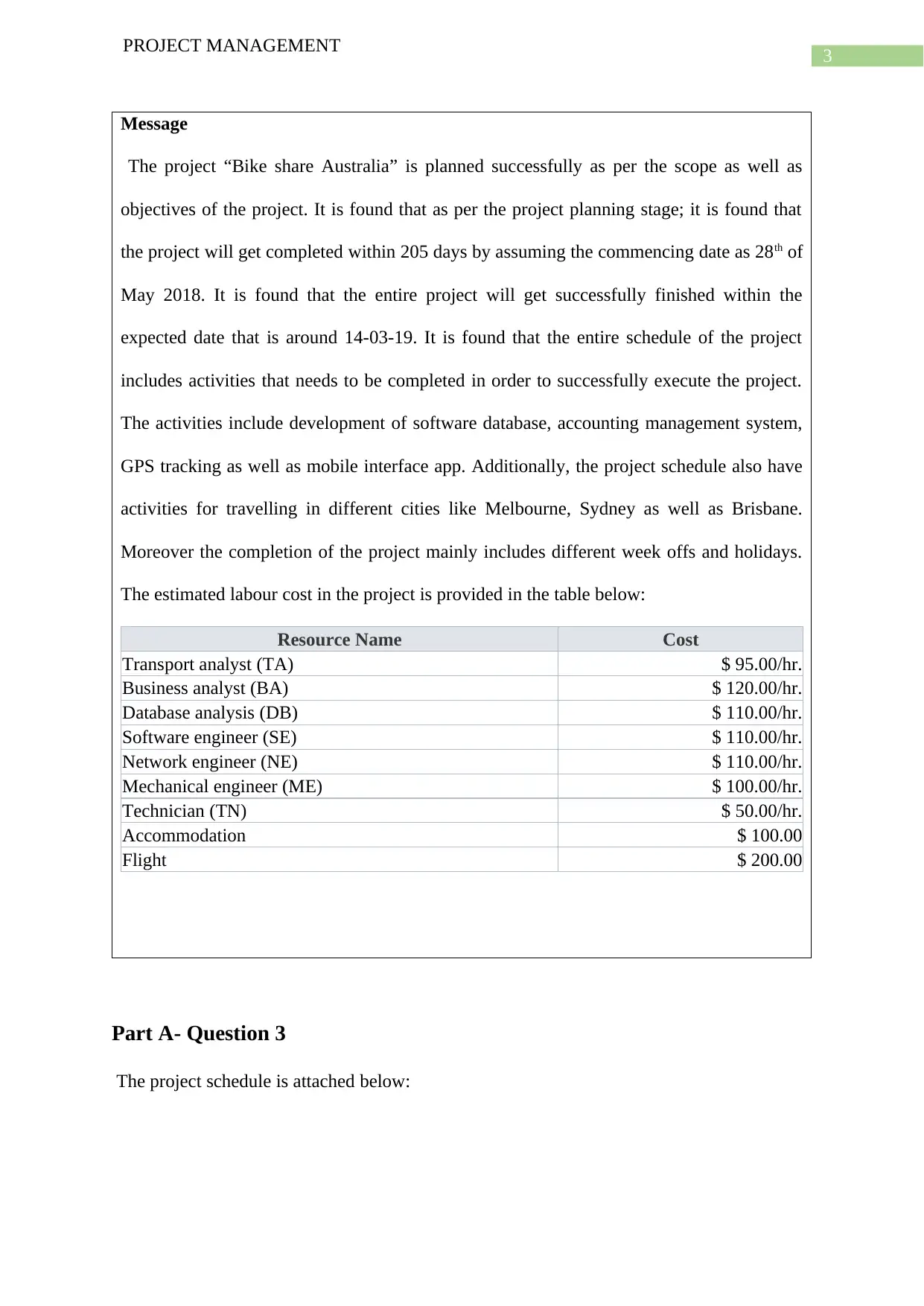
3
PROJECT MANAGEMENT
Message
The project “Bike share Australia” is planned successfully as per the scope as well as
objectives of the project. It is found that as per the project planning stage; it is found that
the project will get completed within 205 days by assuming the commencing date as 28th of
May 2018. It is found that the entire project will get successfully finished within the
expected date that is around 14-03-19. It is found that the entire schedule of the project
includes activities that needs to be completed in order to successfully execute the project.
The activities include development of software database, accounting management system,
GPS tracking as well as mobile interface app. Additionally, the project schedule also have
activities for travelling in different cities like Melbourne, Sydney as well as Brisbane.
Moreover the completion of the project mainly includes different week offs and holidays.
The estimated labour cost in the project is provided in the table below:
Resource Name Cost
Transport analyst (TA) $ 95.00/hr.
Business analyst (BA) $ 120.00/hr.
Database analysis (DB) $ 110.00/hr.
Software engineer (SE) $ 110.00/hr.
Network engineer (NE) $ 110.00/hr.
Mechanical engineer (ME) $ 100.00/hr.
Technician (TN) $ 50.00/hr.
Accommodation $ 100.00
Flight $ 200.00
Part A- Question 3
The project schedule is attached below:
PROJECT MANAGEMENT
Message
The project “Bike share Australia” is planned successfully as per the scope as well as
objectives of the project. It is found that as per the project planning stage; it is found that
the project will get completed within 205 days by assuming the commencing date as 28th of
May 2018. It is found that the entire project will get successfully finished within the
expected date that is around 14-03-19. It is found that the entire schedule of the project
includes activities that needs to be completed in order to successfully execute the project.
The activities include development of software database, accounting management system,
GPS tracking as well as mobile interface app. Additionally, the project schedule also have
activities for travelling in different cities like Melbourne, Sydney as well as Brisbane.
Moreover the completion of the project mainly includes different week offs and holidays.
The estimated labour cost in the project is provided in the table below:
Resource Name Cost
Transport analyst (TA) $ 95.00/hr.
Business analyst (BA) $ 120.00/hr.
Database analysis (DB) $ 110.00/hr.
Software engineer (SE) $ 110.00/hr.
Network engineer (NE) $ 110.00/hr.
Mechanical engineer (ME) $ 100.00/hr.
Technician (TN) $ 50.00/hr.
Accommodation $ 100.00
Flight $ 200.00
Part A- Question 3
The project schedule is attached below:
Paraphrase This Document
Need a fresh take? Get an instant paraphrase of this document with our AI Paraphraser
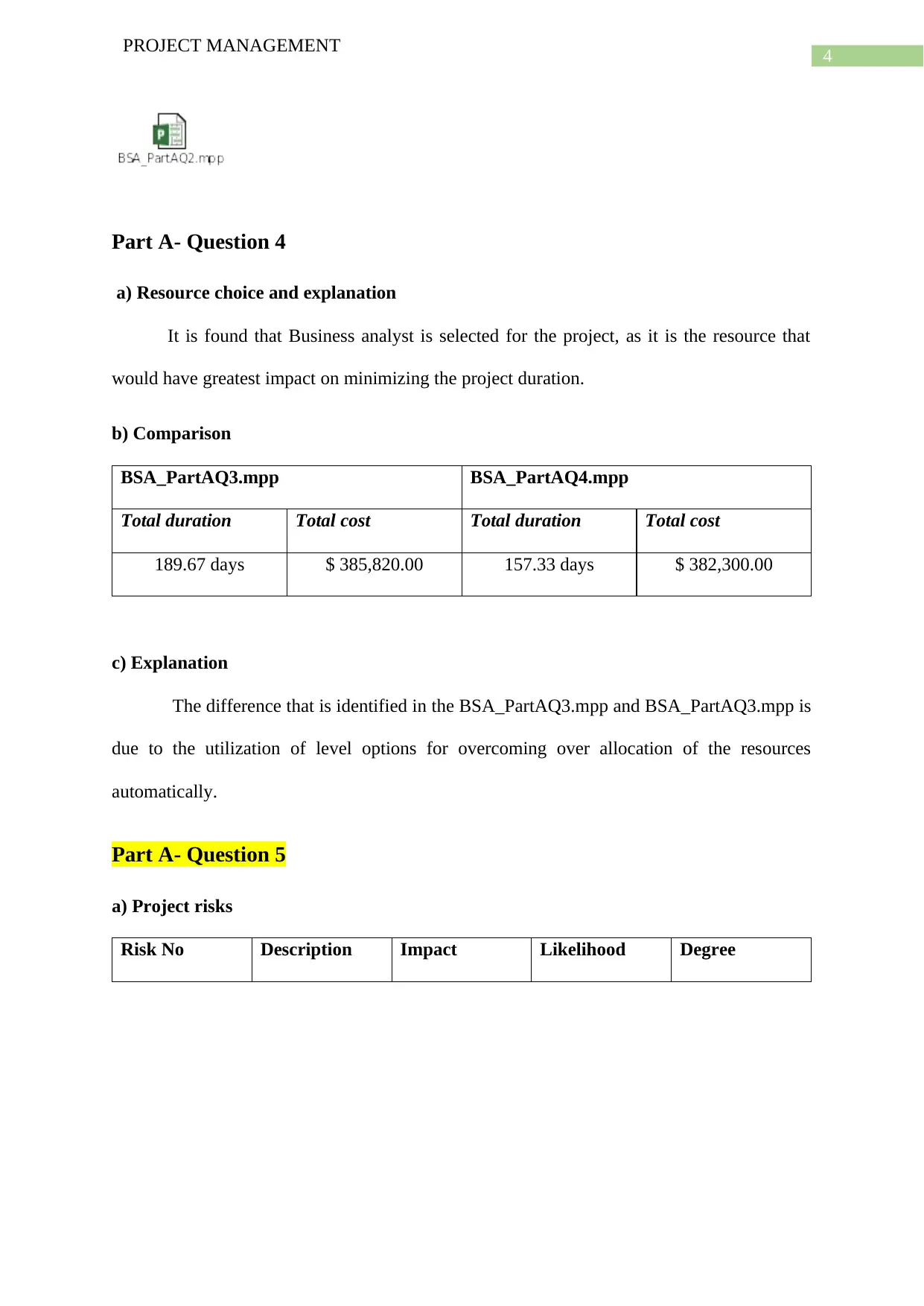
4
PROJECT MANAGEMENT
Part A- Question 4
a) Resource choice and explanation
It is found that Business analyst is selected for the project, as it is the resource that
would have greatest impact on minimizing the project duration.
b) Comparison
BSA_PartAQ3.mpp BSA_PartAQ4.mpp
Total duration Total cost Total duration Total cost
189.67 days $ 385,820.00 157.33 days $ 382,300.00
c) Explanation
The difference that is identified in the BSA_PartAQ3.mpp and BSA_PartAQ3.mpp is
due to the utilization of level options for overcoming over allocation of the resources
automatically.
Part A- Question 5
a) Project risks
Risk No Description Impact Likelihood Degree
PROJECT MANAGEMENT
Part A- Question 4
a) Resource choice and explanation
It is found that Business analyst is selected for the project, as it is the resource that
would have greatest impact on minimizing the project duration.
b) Comparison
BSA_PartAQ3.mpp BSA_PartAQ4.mpp
Total duration Total cost Total duration Total cost
189.67 days $ 385,820.00 157.33 days $ 382,300.00
c) Explanation
The difference that is identified in the BSA_PartAQ3.mpp and BSA_PartAQ3.mpp is
due to the utilization of level options for overcoming over allocation of the resources
automatically.
Part A- Question 5
a) Project risks
Risk No Description Impact Likelihood Degree
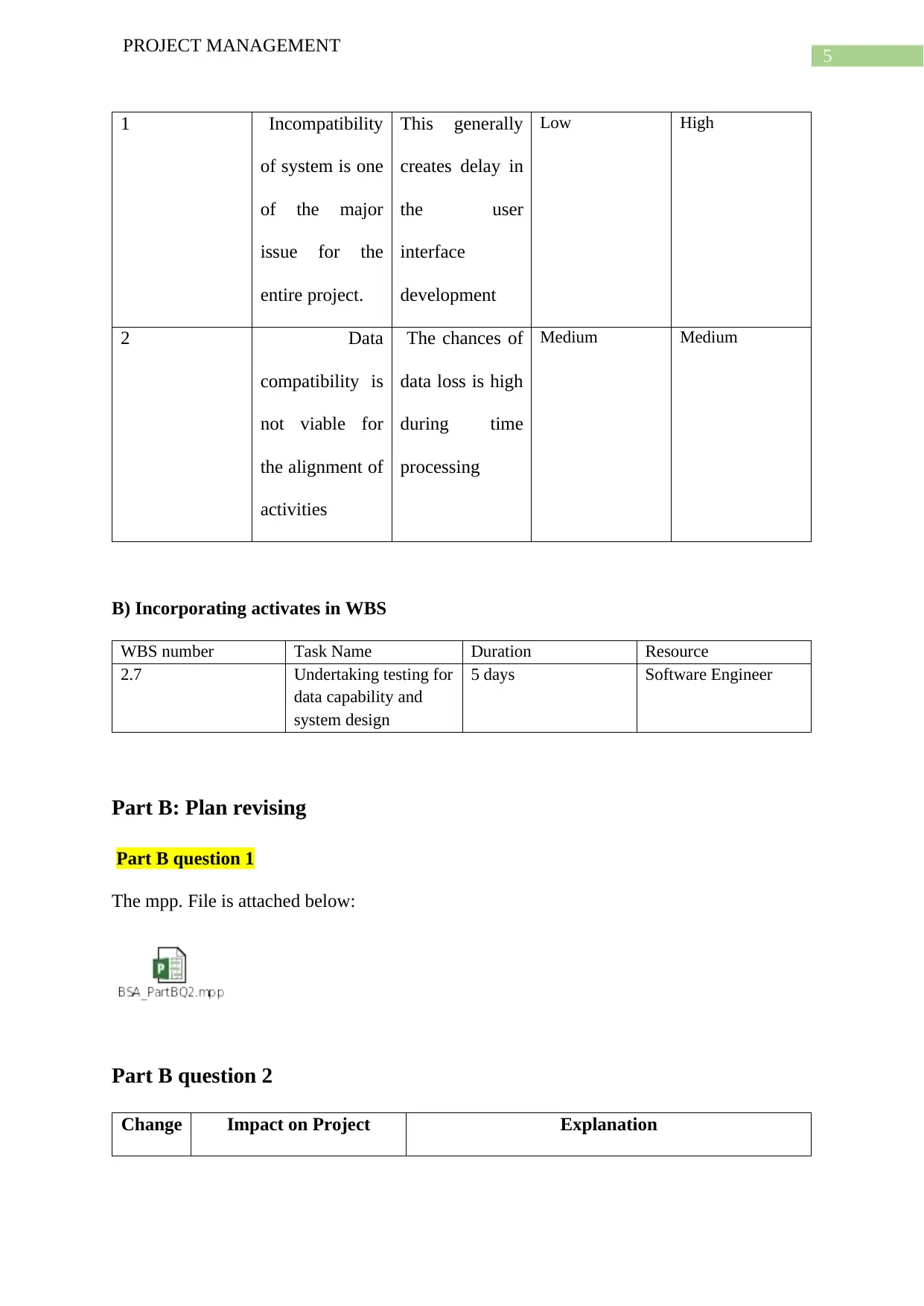
5
PROJECT MANAGEMENT
1 Incompatibility
of system is one
of the major
issue for the
entire project.
This generally
creates delay in
the user
interface
development
Low High
2 Data
compatibility is
not viable for
the alignment of
activities
The chances of
data loss is high
during time
processing
Medium Medium
B) Incorporating activates in WBS
WBS number Task Name Duration Resource
2.7 Undertaking testing for
data capability and
system design
5 days Software Engineer
Part B: Plan revising
Part B question 1
The mpp. File is attached below:
Part B question 2
Change Impact on Project Explanation
PROJECT MANAGEMENT
1 Incompatibility
of system is one
of the major
issue for the
entire project.
This generally
creates delay in
the user
interface
development
Low High
2 Data
compatibility is
not viable for
the alignment of
activities
The chances of
data loss is high
during time
processing
Medium Medium
B) Incorporating activates in WBS
WBS number Task Name Duration Resource
2.7 Undertaking testing for
data capability and
system design
5 days Software Engineer
Part B: Plan revising
Part B question 1
The mpp. File is attached below:
Part B question 2
Change Impact on Project Explanation
⊘ This is a preview!⊘
Do you want full access?
Subscribe today to unlock all pages.

Trusted by 1+ million students worldwide
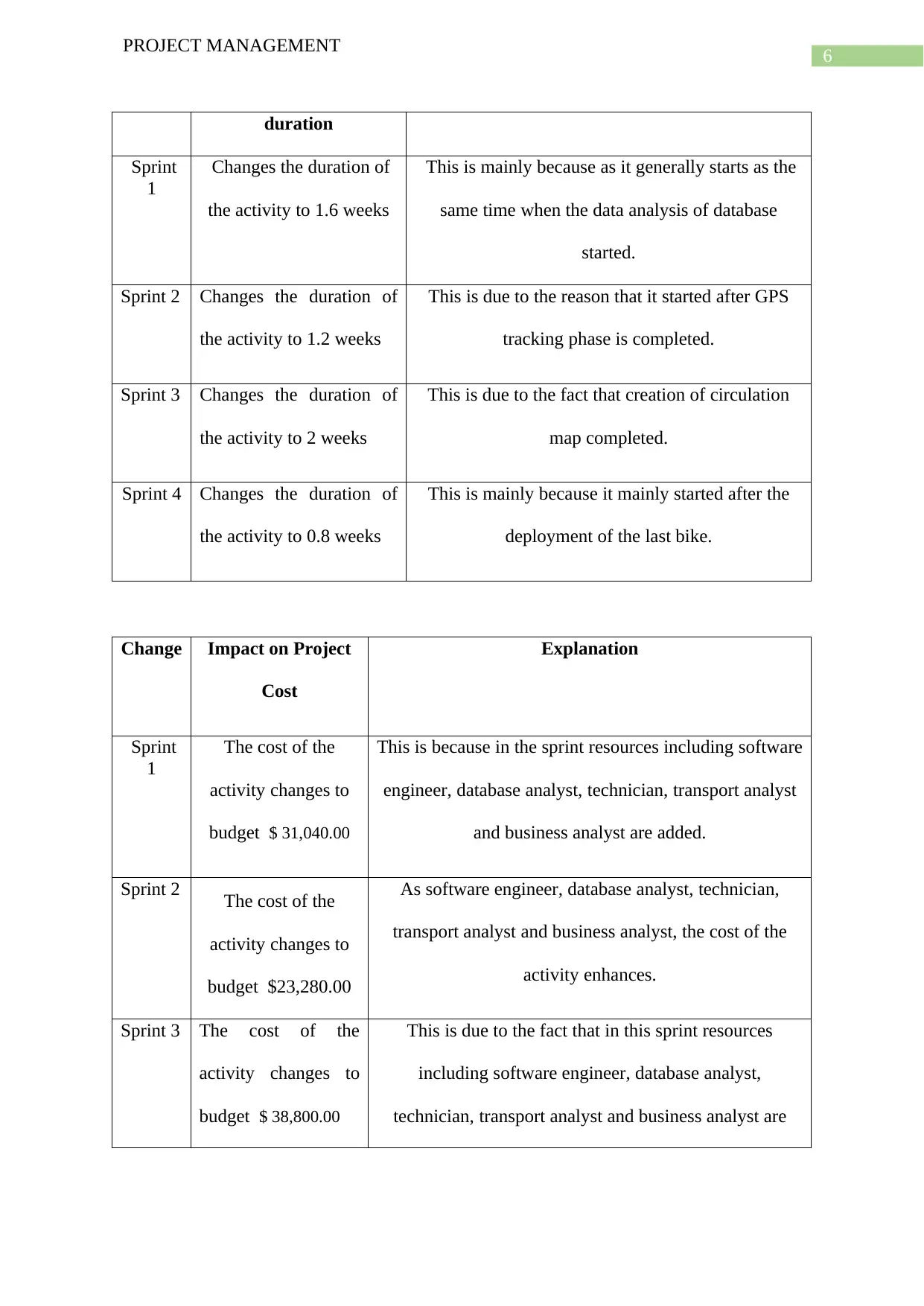
6
PROJECT MANAGEMENT
duration
Sprint
1
Changes the duration of
the activity to 1.6 weeks
This is mainly because as it generally starts as the
same time when the data analysis of database
started.
Sprint 2 Changes the duration of
the activity to 1.2 weeks
This is due to the reason that it started after GPS
tracking phase is completed.
Sprint 3 Changes the duration of
the activity to 2 weeks
This is due to the fact that creation of circulation
map completed.
Sprint 4 Changes the duration of
the activity to 0.8 weeks
This is mainly because it mainly started after the
deployment of the last bike.
Change Impact on Project
Cost
Explanation
Sprint
1
The cost of the
activity changes to
budget $ 31,040.00
This is because in the sprint resources including software
engineer, database analyst, technician, transport analyst
and business analyst are added.
Sprint 2 The cost of the
activity changes to
budget $23,280.00
As software engineer, database analyst, technician,
transport analyst and business analyst, the cost of the
activity enhances.
Sprint 3 The cost of the
activity changes to
budget $ 38,800.00
This is due to the fact that in this sprint resources
including software engineer, database analyst,
technician, transport analyst and business analyst are
PROJECT MANAGEMENT
duration
Sprint
1
Changes the duration of
the activity to 1.6 weeks
This is mainly because as it generally starts as the
same time when the data analysis of database
started.
Sprint 2 Changes the duration of
the activity to 1.2 weeks
This is due to the reason that it started after GPS
tracking phase is completed.
Sprint 3 Changes the duration of
the activity to 2 weeks
This is due to the fact that creation of circulation
map completed.
Sprint 4 Changes the duration of
the activity to 0.8 weeks
This is mainly because it mainly started after the
deployment of the last bike.
Change Impact on Project
Cost
Explanation
Sprint
1
The cost of the
activity changes to
budget $ 31,040.00
This is because in the sprint resources including software
engineer, database analyst, technician, transport analyst
and business analyst are added.
Sprint 2 The cost of the
activity changes to
budget $23,280.00
As software engineer, database analyst, technician,
transport analyst and business analyst, the cost of the
activity enhances.
Sprint 3 The cost of the
activity changes to
budget $ 38,800.00
This is due to the fact that in this sprint resources
including software engineer, database analyst,
technician, transport analyst and business analyst are
Paraphrase This Document
Need a fresh take? Get an instant paraphrase of this document with our AI Paraphraser

7
PROJECT MANAGEMENT
added which leads to increment of project cost
Sprint 4 The cost of the
activity changes to
budget $ 15,520.00
As software engineer, database analyst, technician,
transport analyst and business analyst, the cost of the
activity increases.
PROJECT MANAGEMENT
added which leads to increment of project cost
Sprint 4 The cost of the
activity changes to
budget $ 15,520.00
As software engineer, database analyst, technician,
transport analyst and business analyst, the cost of the
activity increases.
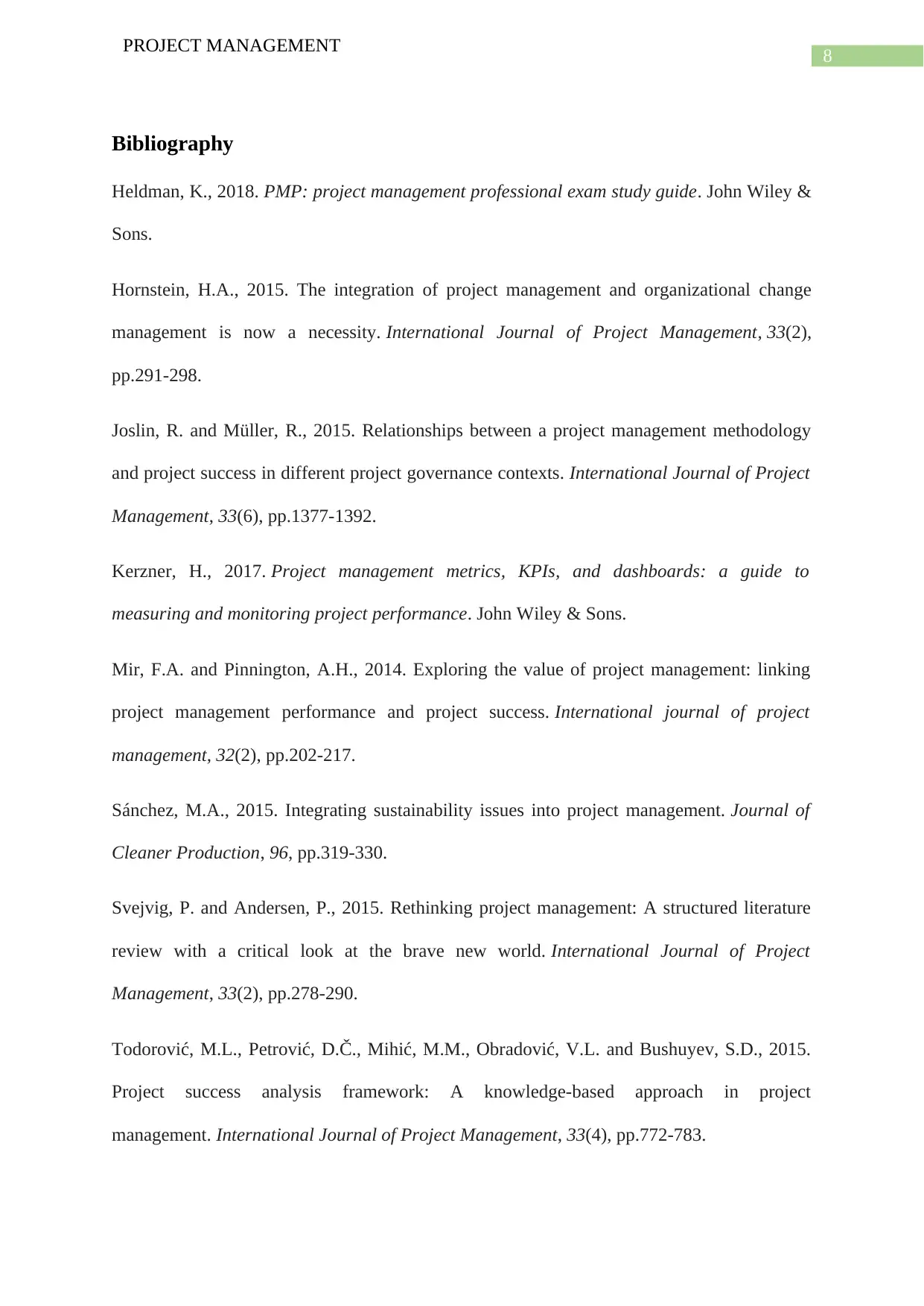
8
PROJECT MANAGEMENT
Bibliography
Heldman, K., 2018. PMP: project management professional exam study guide. John Wiley &
Sons.
Hornstein, H.A., 2015. The integration of project management and organizational change
management is now a necessity. International Journal of Project Management, 33(2),
pp.291-298.
Joslin, R. and Müller, R., 2015. Relationships between a project management methodology
and project success in different project governance contexts. International Journal of Project
Management, 33(6), pp.1377-1392.
Kerzner, H., 2017. Project management metrics, KPIs, and dashboards: a guide to
measuring and monitoring project performance. John Wiley & Sons.
Mir, F.A. and Pinnington, A.H., 2014. Exploring the value of project management: linking
project management performance and project success. International journal of project
management, 32(2), pp.202-217.
Sánchez, M.A., 2015. Integrating sustainability issues into project management. Journal of
Cleaner Production, 96, pp.319-330.
Svejvig, P. and Andersen, P., 2015. Rethinking project management: A structured literature
review with a critical look at the brave new world. International Journal of Project
Management, 33(2), pp.278-290.
Todorović, M.L., Petrović, D.Č., Mihić, M.M., Obradović, V.L. and Bushuyev, S.D., 2015.
Project success analysis framework: A knowledge-based approach in project
management. International Journal of Project Management, 33(4), pp.772-783.
PROJECT MANAGEMENT
Bibliography
Heldman, K., 2018. PMP: project management professional exam study guide. John Wiley &
Sons.
Hornstein, H.A., 2015. The integration of project management and organizational change
management is now a necessity. International Journal of Project Management, 33(2),
pp.291-298.
Joslin, R. and Müller, R., 2015. Relationships between a project management methodology
and project success in different project governance contexts. International Journal of Project
Management, 33(6), pp.1377-1392.
Kerzner, H., 2017. Project management metrics, KPIs, and dashboards: a guide to
measuring and monitoring project performance. John Wiley & Sons.
Mir, F.A. and Pinnington, A.H., 2014. Exploring the value of project management: linking
project management performance and project success. International journal of project
management, 32(2), pp.202-217.
Sánchez, M.A., 2015. Integrating sustainability issues into project management. Journal of
Cleaner Production, 96, pp.319-330.
Svejvig, P. and Andersen, P., 2015. Rethinking project management: A structured literature
review with a critical look at the brave new world. International Journal of Project
Management, 33(2), pp.278-290.
Todorović, M.L., Petrović, D.Č., Mihić, M.M., Obradović, V.L. and Bushuyev, S.D., 2015.
Project success analysis framework: A knowledge-based approach in project
management. International Journal of Project Management, 33(4), pp.772-783.
⊘ This is a preview!⊘
Do you want full access?
Subscribe today to unlock all pages.

Trusted by 1+ million students worldwide
1 out of 9